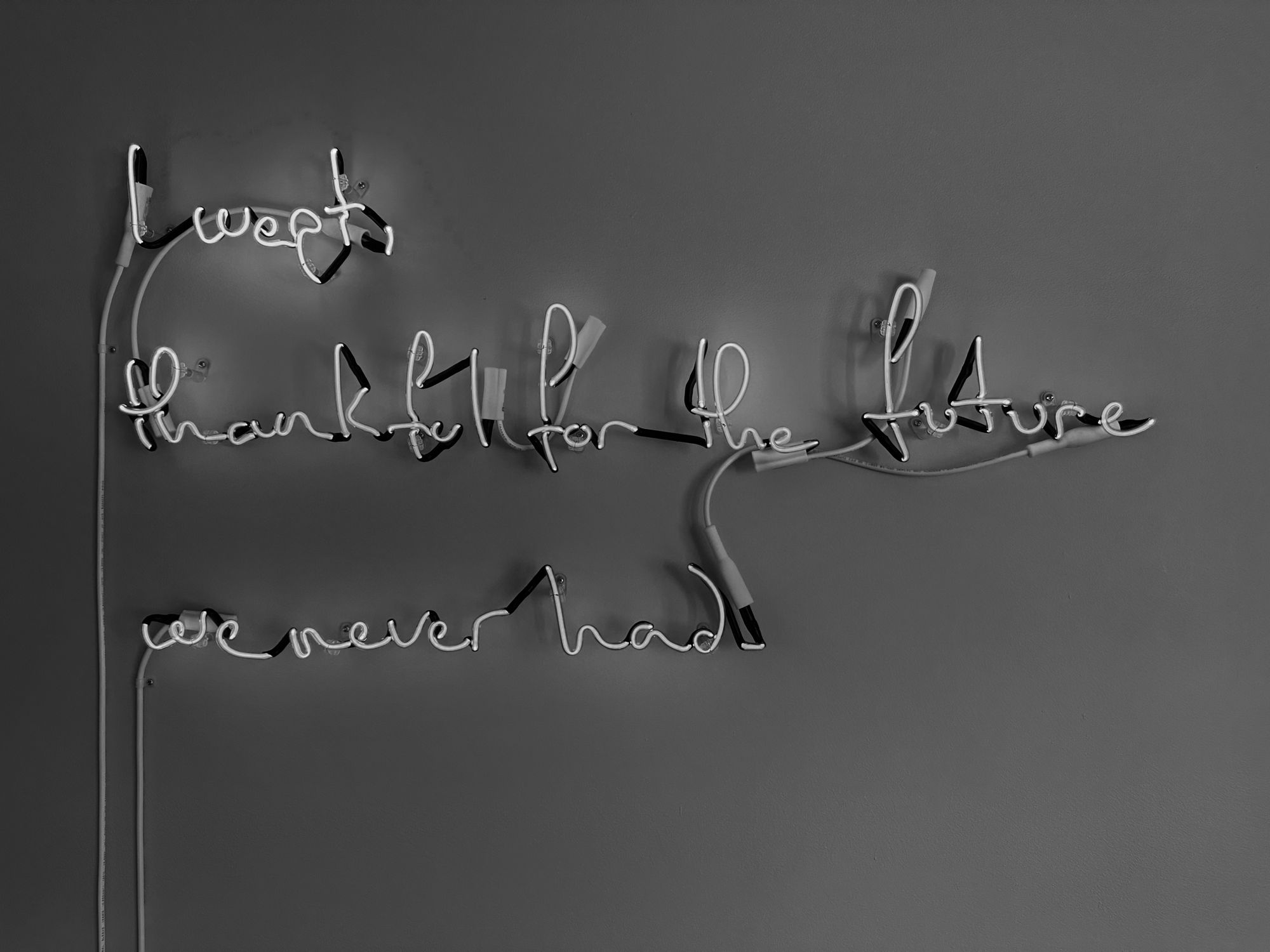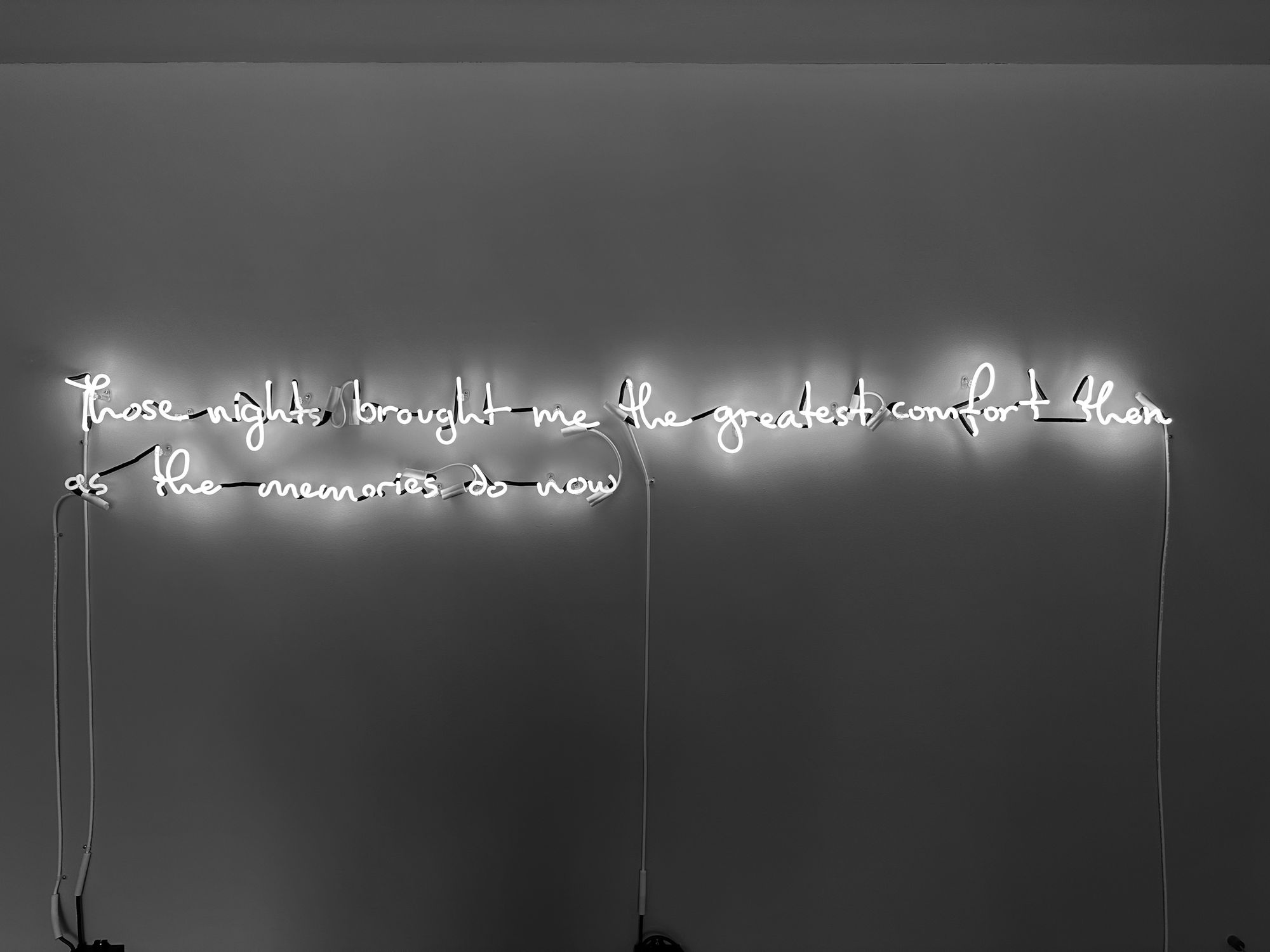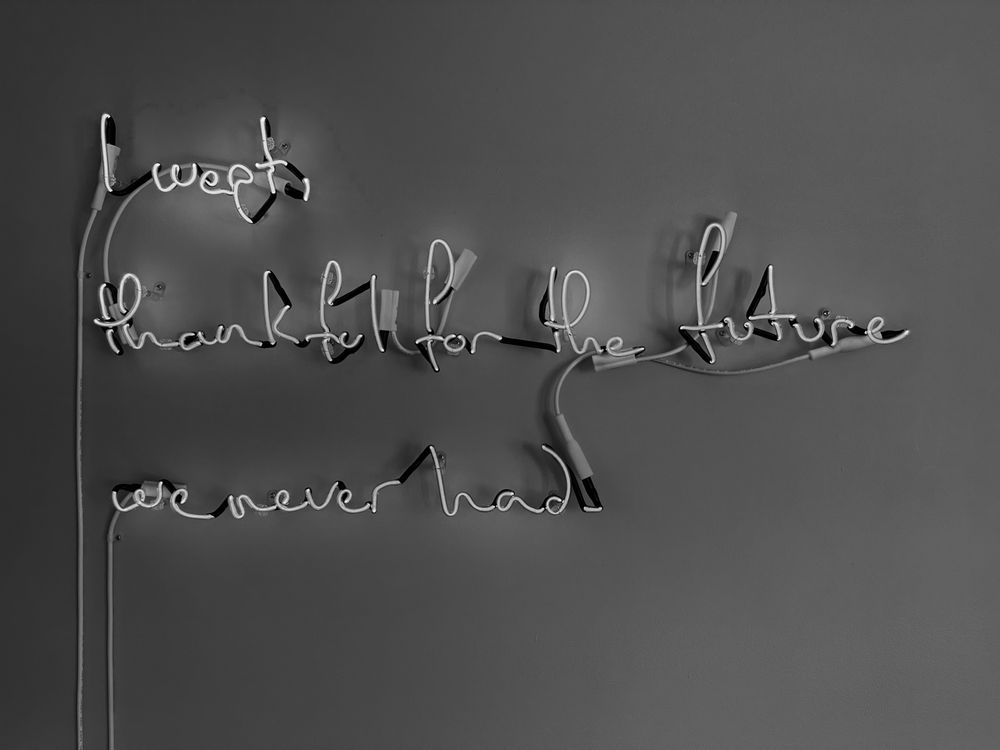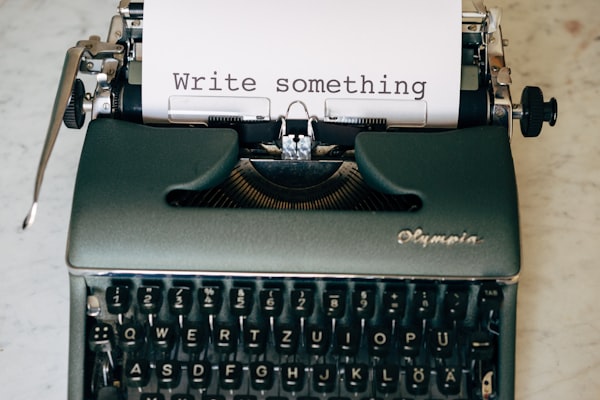A Conversation with Stephanie Sara Lifshutz
by Cristian Andersson
Cristian Andersson: Looking at your website, I saw that at one point you were doing a lot of photography. Then you moved into a large performance piece that incorporated sculpture and a neon work. And now you seem to be very focused on your neon pieces. Do these shifts in medium work off of each other, or are they all in their own seperate little bubbles as your career has progressed? And is there one medium that you feel most comfortable working within?
Stephanie Sara Lifshutz: I think the best answer is the fact that I love making things, and I love making art. Working with my hands is a compulsion. I would always make anything, even if I weren’t an artist. It would be a daily life practice. And so I’m drawn to all mediums because of that. I can’t stay away. I love learning, and I love touching things. And I love connecting with people. And connecting with people is the reason I make art.
When I want to make something, it’s concept first, and medium is determined based on that. What is the best way to communicate my message and connect it outward. I start out with an idea, determine the best way to develop it, and choose the medium that makes most sense. It took a lot of time to figure out what would work best. There was a lot of trial and error.
I don’t know that I’ve said goodbye to any of those mediums. I still carry cameras with me everywhere I go, even if I’m not showing photography. Still do printmaking for some work—little odd small pieces here and there. I’m working on a sculpture right now. So I feel like these are all just extra tools in my skill set. I don’t really see them as a linear path. And even though some have taken up larger spaces at one time or another, compared to each other, I just love all of them.
I think part of the journey is also about what I had the ability to learn at different times. I started off with an undergrad mentor who was phenomenal in photography and printmaking. Got to go to grad school, and really learned from even more performance artists, a continuation on what I had started to learn in undergrad. And then got to do neon for the first time. So I was definitely pushing myself in each medium at various times based on my access. But at this point, I feel like I can call back on any of them just based on what I want to do at the moment.
CA: Knowing how these different mediums have fit your past messages, do you still challenge yourself? In other words, even if you have determined that neon solved a particular problem before, do you just always default to that?
SSL: That’s a good question. And it’s true, I am making things harder on myself at certain times. I’m currently in the midst of working on a piece that would be infinitely easier if I did it in a different medium. It’s a very, very large piece of neon text, larger than I’ve ever done before. It’s a lot of work. It’s a lot of money. It’s going to be very difficult to install. But I know that the impact will be so much more potent doing it in neon, doing it at scale, and at the brightness compared to a print or a book.
CA: Do you have a place where that’s going to be installed?
SSL: I am intending to debut it at Var Gallery, the gallery that represents me in Milwaukee. They’re great to work with and we’ve had a wonderful ongoing relationship. I first showed with them as part of a group show back in 2019, and then we started to work together—formed a partnership. I’m really happy that they’re representing my work. I feel like they’re doing a great job.
CA: In 2022 you had a neon works exhibition at Var in Milwaukee, similar to the one you now have at the Bergstrom-Mahler Museum of Glass in Neenah. Two very different spaces–geographically, physically, and in the work they typically exhibit. When you were deciding to which work would go in these exhibitions, did you think that one would work better in Milwaukee over Neenah, and vice versa? How the neon literally reflects off of the glassworks, both historic and contemporary, at the Bergstrom-Mahler vs. the streets of Milwaukee?
SSL: I’m never concerned with the location. What I am always concerned with is how the work interacts with each other within a location. What are the shape of rooms. Whether or not there are little nooks and crannies to hide some pieces or if all the pieces will be working within the same space. That’s what I think about. I’m always thinking about how one work communicates with the next, and how it can tell a story through the way that you walk around the space. So, in that sense, it does make a difference.
At Var Gallery, there are little hidden spots. There’s a second floor. So in that space, I felt more comfortable showing work that wasn’t necessarily part of the same series or made at the same time, but was connected in other ways. Because we had a separation of physical space between those pieces, it gave them some breathing room conceptually. And at the Bergstrom-Mahler in Neenah, I really wanted to make sure that everything works well together—that you can walk in, follow a path, follow a story. And not just conceptually, but also visually. I want to make sure that the colors interact well with each other, or if they don’t, that they’re not hurting each other and hurting your experience of seeing each piece individually. Those are things I’m always thinking about. Everyone at Bergstrom-Mahler has been incredible to work with: working on the technical preparations, considering how the sunlight is coming into the room, and making modifications if necessary in that sense. So, those are details that I like to go over on “Space to Space.”
I think it’s exciting to be able to show in different spaces, because the viewer interacts in a different way. It’s funny, earlier you mentioned people not necessarily understanding neon art, and that’s exactly what’s happened. Josh Hintz, owner of Art Gallery, related a funny story. When I had that show in 2022, a man came in off the street and looked around and then said, “Where’s the art? Where do I go?” Well, we’re in it. This is the show. And it’s something that comes up a lot, and it’s an interesting conversation to have. And, at times, it can be frustrating. I’ve certainly been rejected from shows in the past, being told that’s just a sign. We’re looking for art here. So, that’s always a conversation and challenge. And having a gallery versus a public space versus a museum really helps change the context for the viewers, in terms of preparation in entering the space.
CA: Does the venue affect how people see the work? As in, does the space it is being shown help validate it as capital-a art in people’s minds?
SSL: I think in a museum, and this is a massive generalization, but generally speaking when we walk into a museum I think we’re being told, “This is art. You can hate it, but we have determined that this is it.” And so, there’s an automatic acceptance of what we’re looking at. In a gallery space, well, lines can be blurred a little bit with commercial spaces. So, you may not know what’s what. Is this a sign telling me that the bar is over there? Because I did make a neon sign for Var saying that—that’s the gallery bar—or is this a piece of art? And in the gallery space, that’s something I really like to play with. They’re very, very open to letting me hide little pieces behind walls or around the corner or up in a ceiling just to kind of just play with the people that are coming in a little bit.

CA: For me, neon work is so conceptual. Sure there is the visual aspect—the script, the color, the physicality—but when I look at the work so much is happening in my head. What is the conversation Stephanie is trying to have with me through her work. Sure, that happens with other forms of art, but there is something about text on a wall that makes it more performative. Why did you decide to go in this direction with your art? Why did you say, you know, I’m going to choose the thing that most people would say is not art and use that to share my message?
SSL: I first got into neon without the intention of necessarily using it in my practice. I was in graduate school at it was so exciting to be at a place that has so many studios, and access to so many mediums. And, you know, I just wanted to take advantage of every opportunity. Going to college was really exciting. The school I went to was unaffordabe. I was there on a lot of scholarships and I’m currently in a lot of debt. And so, I wanted to take advantage of every single opportunity there. And the same thing followed with graduate school, even if I was getting tuition remission. I was just so appreciative to be there, and I wanted to take advantage of every single second. If I had the opportunity to learn something new, I was going do it.
And I wasn’t good at the neon work at all. I was terrible. I was just going over my transcripts for a teaching job, and I got like a BC in the class. But it just pushed me further to get to that point and really get comfortable with the medium. Eventually after so much time with it, it really started to make sense. I was making work in other mediums, but it didn’t feel right. Like I was getting most of the way there, but I wasn’t there. I wasn’t making the work that I felt like I should be making. It was missing the neon. I was struggling so much to get a message across based on my writings, my notes, my drawings. And I realized at the end of the day, I just needed to literally say what I wanted to say with the words that I had written. Not try to work it into imagery, not try to work it into photography or sculpture, but just get it out there in a bright light. And so it all started to make sense. And I feel very lucky in that way, because I don’t know where my work would be if I hadn’t found the medium that really felt like it was doing what I wanted.
CA: Where do arrive at the words that you’re going to be using? Your artist statement talks a bit about societal structures that you grew up in… and then there were works that came around in the time of COVID.
SSL: I definitely feel like there’s the first stage of making work with neon, and then the current stage. The first stage was really working through suggested commands, working with just individual words or three words—very short phrases. That’s what comes out of my interactions with other people. All of that work comes out of those expectations. My family has always encouraged me to be very loud and assertive and outspoken and proud of myself. And entering the world, a lot of people didn’t want that. And that’s hard. That’s a really hard thing to realize that you’re supposed to be quieter as a woman in a lot of spaces. Of course, a lot has changed over my lifetime. I’m pretty young, but a lot has changed over those 15 years, I’d say, of me being out and about in the world and the workforce. And thankfully, it’s very different in a lot of spaces now, but it certainly was horrible then and for a long time. And so that’s what really pushed me to make those works—just things that I have said to other people or things I had wished I had said to those other people.
I really loved playing with the history of signage in order to get that message across. Neon signs historically always tell us what is there or what to do, parking over here, no vacancy, all of that. And I loved playing with that history as I got comfortable working in the medium and finding my own voice. And then I started to realize, oh, I can make whatever I want in this medium. And, now, everything that I’ve created have been excerpts from my writing.
CA: Reflecting on what you said—that there may be expectations that women are supposed to be quieter in many spaces—and then thinking of the seminal neon artist Chryssa… are there a lot of women artists taking up neon to put their voice out bright and loud? Is there a tradition?
SSL: There are now. The landscape of the neon industry, both commercially and as an art practice, has shifted considerably over the past 10 years alone. I started out seven or eight years ago, working in a neon shop. I worked in that neon shop to really get comfortable with the technique because technique is essential for me. And so much has changed even since then. At that time, I couldn’t find other women who were doing the neon bending itself. There are a few, some trailblazers who have been doing this for decades—quite a few on the West Coast—but I didn’t know them. I didn’t know them personally. I didn’t get to see them in my daily life. And it was a really hard experience, but as I and other women kept pushing in the industry, other people started taking classes from us and realizing that it can be a welcome environment in our little microcosms. And once you build up enough people like that, you get a whole new generation of women and queer folks and just younger people in general, interested in the medium and feeling okay and welcome. And that’s exciting.
CA: What are some artists that have inspired you? And are there any artists that would be really surprising to know that they are someone that Stephanie looks on as a touchstone?
SSL: I like how you phrased that question because I would definitely say there were the artists that shaped me and then the people I look up to now, which I think would be more surprising. Getting into art when I was a kid in high school, I just absolutely loved being able to play with people in a fun way. So I love Allan and Ellen Wexler’s work. I love their furniture. I love their public installations. And I love how much thought goes into the design and that you don’t necessarily see. You have to put in a little bit of work to understand what’s really going on there. And that’s something I take to heart to this day. It really influences my work in that I think—anyone can look at it, anyone can connect to it, but the more you dive into understanding the work, the more you get to know about me. It goes from you seeing something about yourself to then you seeing a connection between us. And that’s something that I really strive for.
There are performance artists that mean a lot to me, like Janine Antoni and Nina Katchadourian—I had a wonderful opportunity to meet both of them in college. That was incredibly exciting. Maurizio Cattelan’s exhibition at the Guggenheim when I was younger… that was incredible. It was the first time I looked at sculpture and I thought, is this art? And then I thought anything can be art. And that was an exciting and a very fulfilling moment. But nowadays, the people I really look up to are storytellers in film. I look up to a lot of screenwriters and directors. I avidly follow some of their work, like Will Sharpe, Sharon Horgan—huge fan of Sharon Horgan’s work. She’s a fantastic writer, director, and actor. Russell T Davies. A lot of British and Irish folks, which I think that has to do with their comfort with dark humor. A lot of my work deals with personal issues, like my feelings dealing with grief or depression or moments of struggle. And so I really appreciate all of their acceptance of the humor that you can get out of a bad situation. And also that they all put a little bit of themselves in their work.
CA: Have you ever thought about doing film?
SSL: I think about doing film all the time. I’ve done some other performance work that I haven’t put on the website. I think there’s always this lingering insecurity about the best way to present it. But I do think about film constantly. I can see the movie in my head that I want to create, and there’s always a fear that it will never be as good as what I’m actually seeing. And I can see every detail so vividly. It’s something that interests me tremendously.
CA: Well, I hope that you take the chance to do that. You are someone who seems so conscious of the work you’re doing and I can’t imagine that it would be a complete failure.
In Wisconsin, and certianly in our youth, we don’t always get the chance to go see those beautiful shows at the Guggenheim. What art the public generally gets to see firsthand is pretty limited around here, unfortunately. What advice would you give young artists as they’re starting a career? And was there any advice you wish you had when you were a young artist, looking back now?
SSL: I think the advice that I wish I had is the advice I got, because I was so lucky to have mentors that were fantastic. John Holmgren, who does photography and printmaking, Virginia Maksymowicz, who taught me everything from woodworking to bronze casting, and Tom Jones’ photography over at UW—Madison. They made us work hard and they prepared us. And I cannot be more thankful for that. And that advice was: this is going to be a job and it’s going to be a very, very tough job. And realistically, it’s not going to be your only job. It’s going to be a full-time job in addition to another full-time job. And they taught us how to take the raw and valuable skills that we had and apply those to make money. Because not everything that we get to do is the art that comes from our heart. Realistically, there’s no glamor in a struggling artist’s life. And most of us can’t afford to cosplay that. It’s real work. And that prepared me for the real job that I have now of being an artist and also a fabricator and a teacher. And that advice was invaluable because it helped me stay humble. Stay humble, another word of advice I give to everyone of every age, because we’re always learning. And there’s always someone who’s better than you at doing something. There’s always something to learn and there’s always someone who knows more than you. So be ready to accept that advice and knowledge and experience from someone else and work hard at it.
CA: What do you think we as artists could use more of from our community to help support us?
SSL: We need more outside help. We need more outside funding. I feel as a community we do a lot to support each other, but it’s still challenging whenever someone is starting their own place or starting their own organization. Everyone’s fundraising. I feel like we’re just helping each other out, but passing the same $20 bills around from hand to hand. And that leans into the generosity that we all have for one another, but we need further outside funding. You know, some states are much better at it than others. The country as a whole had a nice period of being better all around. But I think that’s what we need.
Born and raised in Brooklyn, New York, Stephanie Sara Lifshutz received her MFA in 4D/time-based art at the University of Wisconsin-Madison in 2016. Growing up in a Modern-Orthodox Jewish household gave Lifshutz the desire to become involved in the Jewish Artist Lab in Madison, WI and serve as its artist-in-residence. Lifshutz pursues her art with an interdisciplinary approach, and incorporates that theme into her photography, printmaking, and sculpture, as well as her teaching practice. She has shown work nationally, regularly teaches, and has been awarded a Nissley Grant.
Visit Stephanie Sara Lifshutz’ website at www.stephaniesaralifshutz.com




